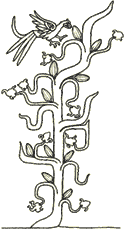|
|
|||||||||
|
Looking strangely alien, dozens of yellow-green pods hung from the trunk and stems of the tree. Our guide picked one of the hand-sized fruits, stripped off the rippled outer layer with his knife, and handed us chunks of the fibrous white pulp inside -- the fruit of the cacao tree. Two local children who had followed us into the forest waited impatiently for their own turn. With practiced hands, a girl of about six borrowed the guide's knife, hacked off the covering from another pod, and shared a big chunk of pulp with her brother. |
The cacao tree (Theobroma cacao) is a native of Central and South America. Today, it is cultivated around the equator, and can be found in the Caribbean, Africa, South-East Asia, and even in the South Pacific Islands of Samoa and New Guinea. There are three main varieties of cacao trees. The most common is Forastero, which accounts for nearly 90% of the world's production of cacao beans. Rarest and most prized are the beans of the Criollo variety. Their aroma and delicacy make them sought after by the world's best chocolate makers. Finally, there is the Trinitario variety of cacao, which is a cross between Criollo and Forastero. The spread of the cacao tree started during the age of Colonialism, as did the spread of cacao beans, and of chocolate itself. Christopher Columbus was the first European to come in contact with cacao. On August 15, 1502, on his fourth and last voyage to the Americas, Columbus and his crew encountered a large dugout canoe near an island off the coast of what is now Honduras. The canoe was the largest native vessel the Spaniards had seen. It was "as long as a galley," and was filled with local goods for trade -- including cacao beans. Columbus had his crew seize the vessel and its goods, and retained its skipper as his guide.
"They seemed to hold these almonds [referring to the cacao beans] at a great price; for when they were brought on board ship together with their goods, I observed that when any of these almonds fell, they all stooped to pick it up, as if an eye had fallen." What Ferdinand and the other members of Columbus' crew didn't know at the time was that cocoa beans were the local currency. In fact, in some parts of Central America, cacao beans were used as currency as recently as the last century. While it is likely that Columbus brought the cacao beans he seized back to Europe, their potential value was initially overlooked by the Spanish King and his court. Twenty years later, however, Spanish conquistador Hernando Cortez is said to have brought back three chests full of cacao beans. This time the beans were recognized as one treasure among the many stolen from the conquered Aztecs.
|


